This entry is the second in a series I'm writing for Curiosity's landing on Mars. The landing will take place on the morning of August 6, and it's going to be the biggest show of technological prowess in the history of space exploration, assuming it succeeds of course.
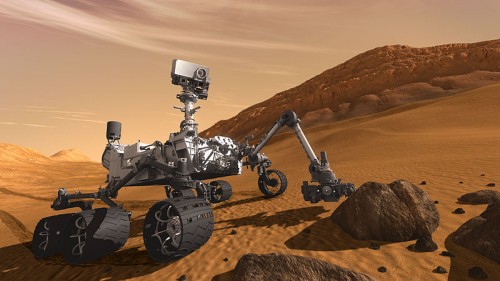
The article was first published on Yoav Landsman's blog: critical mass.
For the first article in the series: How hard is it to land on Mars?
My bet is that the mission will be successful, despite the great complexity of the operation. I tend to think that in a project in which 2.5 billion dollars was invested, at a time when NASA's budget is being cut and the main damage is to planetary research, every effort was made to leave no room for surprises that could destroy the mission. However, there is no such thing as a sure bet.
The mission segment from entering the atmosphere to landing is the most complicated and dangerous phase during the mission. The spaceship changes its shape and mode of operation several times until it reaches the ground, performs for the first time exercises that can in no way be attempted on Earth except with computer simulations, depends on a large number of mechanical and electronic components and is managed by software with countless lines of code. What could go wrong?!
MSL (Mars Science Laboratory, carrying the Curiosity rover) was launched on November 28, 2011 aboard an Atlas launcher, beginning a 254-day journey to Mars. In fact, the original trajectory would have caused it to miss Mars by about 40,000 kilometers, and this gap has only been narrowed in recent months. This is so that in case of a serious malfunction the spacecraft will not crash but will continue to move in orbit around the sun.
Now the spacecraft is moving on a path that will bring it to the entrance to the upper atmosphere of Mars and in the coming days it will make several additional repairs that will precisely adjust the position and angle of the entry so that it will arrive directly at the landing target. The spacecraft is stabilized through a slow spin, and powered by electricity produced by the solar cells on the back of the cruise stage.
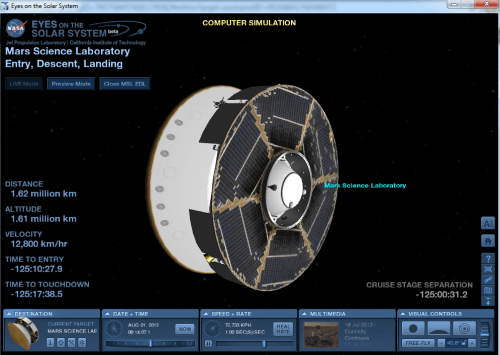
In the five days before entering the atmosphere, a sequence of operations will begin in preparation for the landing, which will include starting to warm up certain components and loading parameters for the spacecraft's autonomous software, for example parameters of its exact position, or the atmospheric conditions in the landing area (as observed by the MRO satellite). These parameters will help the software manage the landing process in an optimal way.
The ceiling of the atmosphere is not an obvious location. The upper layer becomes thinner and thinner as you move away from the ground, and for practical purposes ends at an altitude of about 125 kilometers. The spacecraft does not enter the atmosphere above the landing site, but enters at an obtuse angle over 600 kilometers from the destination. MSL penetrates the atmosphere at a dizzying speed of about six kilometers per second, and its mission is to slow down this speed in order to land the robotic vehicle very gently, and of course in exactly the right position.
The action starts ten minutes before hitting the atmosphere. A number of pyrotechnic devices explode and throw off the cruise stage. MSL remains in free fall over Mars.
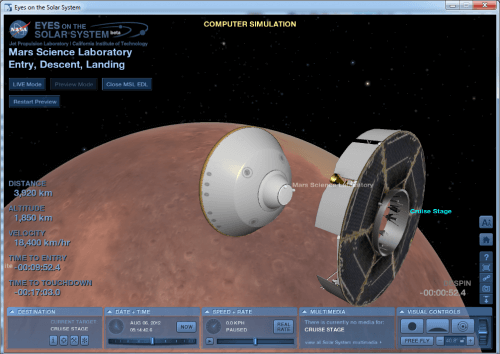
MSL consists of two outer halves, the heat shield, which is built in the shape of a wide cone, and the back shell. The spacecraft waits one minute for the cruise phase to move away, and activates the hydrazine engines on the rear envelope to stop the spin, and to point the heat shield forward, in the direction of the spacecraft's movement and towards meeting the atmosphere.
Five minutes before entering the atmosphere an interesting operation takes place. Two tungsten weights weighing 75 kilograms each are thrown from the back of the spacecraft, thus causing its center of gravity to move forward. This action will cause the spacecraft to gain aerodynamic stability, and in fact produce a certain lifting force. The spacecraft's gyroscopes and rocket engines will allow it to control and control its direction, and keep it on the right path. At this stage it will be possible to offset most of the unexpected disturbances that may be caused by changes in the density of the atmosphere and winds.
The controlled and stabilized entry into the Martian atmosphere can be compared to the ballistic entry of the previous rovers, which were actually subject to the randomness of the atmospheric phenomena, which is the main reason why their landing area was infinitely larger than that of Curiosity.
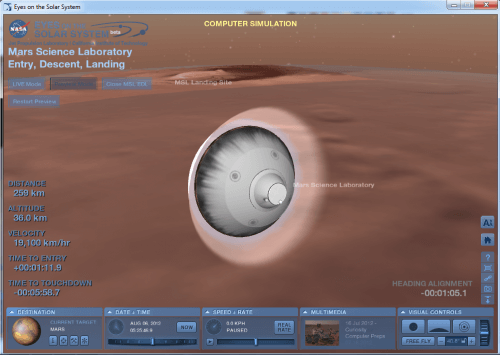
During the friction in the atmosphere, the spacecraft will slow down to 10% of its initial speed. For this purpose, it must survive an acceleration of over 10 G, and a temperature of over 2,000 degrees Celsius, which will be blocked by the heat shield.
At this stage, MSL's speed is expected to be about Mach 2 (2 times the speed of sound), and at this speed it is already possible to deploy the giant parachute specially designed for this mission.
Before deploying the parachute, the spacecraft must be "aligned" so that its radar faces downward and can measure the height and speed of the spacecraft. The "alignment" will be carried out by dropping six tungsten weights of 25 kilograms each, sitting on the same side on the circumference of the spacecraft. The center of gravity changes position again, and the heavier side will rotate downwards.
It's amazing to me that 300 kilograms of tungsten whose only function is to be thrown out was launched into space. But they used to do the same thing with sandbags in balloons, right? (Does anyone know if they still do this?)
During the entire phase of entry into the atmosphere, MSL will be in direct radio contact with Earth, and the transmission will be received by the Deep Space Network. The DSN array includes three transmission and reception sites equipped with huge antennas (70 meters) that enable communication with spacecraft at a very long distance. The sites are in California, Spain and Australia, and together cover all directions around the globe.
In addition to the live broadcast, MSL will also transmit a UHF broadcast to the three orbiters around Mars: Odyssey, Mars-Express, and MRO. All three will record the transmission they receive, but only Odyssey is able to act as a relay that transmits the transmission in real time to Earth. MRO will deliver it after a few hours and Mars-Express will serve as backup only.
The information they will receive is data on the experiences that MSL goes through, such as temperature, pressure, vibrations, and other information that can help future missions to Mars.
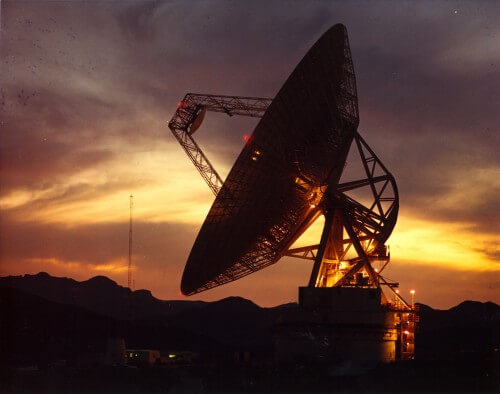
Note that when I wrote real-time, I meant that the transmission would be in real time, but the reception on Earth would be delayed, because the transmission has to travel 248 million kilometers. Radio waves travel at the speed of light, so the time that will pass from the moment of transmission until it reaches the earth is almost 14 minutes.
Continue Curiosity's landing adventures in the next entry.

24 תגובות
Brother, Yehuda…..the man and the Sabdarmish…
You don't know if you need it?
And what about the pressure differences caused in the spaceship during its transitions between our planet and the planets of IT and the other aliens?
to N.C
Tungsten has two interesting properties
High specific gravity over 19 grams per cubic cm
High melting temperature above three thousand degrees
Therefore the volume will be small and there will be no danger of fusion
Do you need it?, I don't know.
good week
Sabdarmish Yehuda
A simple question, why tungsten, why not copper, stainless steel, or even coated lead cylinders?
Thanks to R.H. ghosts
Regarding the occupation, the time I currently spend is about 10 percent and I am looking for what I can do in addition. If anyone has any ideas, I'd appreciate it!
good week
Sabdarmish Yehuda
Yehuda
So start believing that there are people who know what they are doing. And even what they swim on.
For example, you could draw an example from a person like Yoav Landsman.
Apart from that, I wish you success in your pursuits (whether it's retirement or still pursuing business optimization. (:))
To Yoav
I think you were wrong
What matters is the final weight you landed! According to this, all other things must be organized, including the missile
If you landed on Mars weighing 900 kg, it's different if you only land 90 kg - mini curiosity (:))
And I estimate that if they had transferred a mini curiosity to Mars it would have cost much less accordingly
But we really exhausted ourselves on the subject.
And to Mr. Ghost
I long ago stopped believing that people must know what they are doing. It is enough to notice how many mistakes are made, especially in large organizations.
And regarding the degree, I am a graduate of the Shenkar College in industrial management and am involved in factory optimization mainly in the textile and paper industry (those who remain in the industry of course)
(:))
good week
Sabdarmish Yehuda
I know what I wrote. You can't get anywhere from there except into the atmosphere.
Your account is not comparing the right things. The weight of the entire spacecraft at the time of launch is almost 4000 kg, and about 2500 kg enter the atmosphere and not just 900.
It is true that 900 kg landed on Mars, but take into account that for these 900 kg they launched a rocket weighing 335,000 kg, all of which (except Curiosity's 900) were thrown on the way. So what are these 300 kg if not less than one per mille of the weight of the entire mission?
In this period of NASA budget cuts, they are really doing everything to make the mission as efficient and cheap as possible, and the solutions demonstrated in this project are amazing in their creativity under the budgetary constraints.
It is very easy to accuse the engineers of being frivolous without understanding the variety of challenges they have to face, and as someone who knows the business from the inside, and from the answers I received from the people in these projects, it gives the impression that they are serious, experienced and extremely careful.
I am ready to answer questions, but I will not continue this debate.
Yehuda
I'm sure the engineers there thought carefully before they chose the option to throw, "just like that", "over six hundred million dollars".
Come on... Mr. Sabdarmish…
Maybe you just don't know the reason why they did it? (I don't know if it comforts you either)))
And what is a "business optimization engineer"? I hope it's not like "an effective businessman in Hindus".
I am relying on an article in Hidan
https://www.hayadan.org.il/curiosity-powered-up-for-martian-voyage-231111/
Curiosity is a robot weighing 900 kg and other weights weighing 300 kg and 1200 kg, which to bring them to Mars cost 2500 million dollars!!!, hence, each kilogram of shipping to Mars cost over two million dollars. So when you get to Mars they just throw it away?, over six hundred million dollars ?????
So maybe I don't understand much, but this is a mass that is thrown away!! I'm sure I could interest space industries what to do with these 300 kg that will be released near Mars!! Universities would be ready to take advantage of it.
I'm not an aerospace engineer, but I'm an engineer in business optimization and I'm sure that the aforementioned weight could have been used in a better way than just throwing it away.
Yoav Landsman, in an article writes:-
Five minutes before entering the atmosphere an interesting operation takes place. Two tungsten weights weighing 75 kilograms each are thrown from the back of the spacecraft
That is, they are thrown before entering the atmosphere and not as you thought.
waste!!
and R. H. Ghosts - you are wrong and misleading. I rode a BSA Rooster (English) and not a Harley Davidson.
Must be precise
See you Monday morning
good week
Sabdarmish Yehuda
Yoav Landsman
thank you for the answer. Hooke's law seems to work after all.
Yehuda
really. what do you understand
And how good that you're just watching Phobos and Deimos, and enjoying riding a Harley, and not messing around with the engineering of spaceships that have to fly to Phobos or Deimos.
Yehuda, the weights are released in the atmosphere. It is impossible to reach the moons of Mars from there.
If, instead of weights, measuring instruments were thrown, for example, then a communication channel had to be built with them, they had to be designed, manufactured and tested. These things cost a lot of money, while a barbell costs very little.
Weights in spacecraft are not uncommon. In fact, almost every satellite or spacecraft has fixed weights whose purpose is to make the center of gravity be exactly where it is appropriate for the mission (an inaccurate position will cause, for example, the engines to give a different torque than planned).
I was surprised that here there are 300 kg of weights, which is a lot relative to the total weight, but they are not used for balance, but to change the position of the center of gravity, and this is, in my opinion, an innovative and interesting way to deal with the need to change the dynamics and direction of the spacecraft while moving through the atmosphere.
To Yoav Landsman
Again the question arises: was it not possible to use weights instead of just weights, in any experimental measuring device, it does not have to be a tungsten cylinder but any mass of the same weight. For example, they would release a rocket at this mass and try to reach one of the moons Deimos or Phobos, land on it or even just collide with it to understand what it is made of.
It won't help, just getting there just to inject?, I don't accept it.
But, what do I understand?
good week
Sabdarmish Yehuda
To your question regarding the weights - they are only tungsten cylinders, and their release tilts the nose of the spaceship downward relative to the direction of movement. This creates an angle of attack, and anyone who has studied aeronautics or aviation knows that this is how lift is created.
By controlling the lift direction with the rocket engines, the spacecraft is steered without wasting fuel on thrust.
At the press conference two days ago, it was explained that this was the simplest and cheapest method they had. Releasing weights is much simpler and much safer than moving parts and electronics.
Each of the weights is released by a mechanism with built-in redundancy (two explosives, not just one), and it is possible that the landing can still be successful even if not all the weights are released.
Yehuda.
both. It seems to me that moving the weights away causes the main body to rotate (not just change its center of gravity) and this is mainly due to momentum considerations (I may be wrong, details are missing). It seems to me that the journalist also did not understand the maneuver enough, therefore his explanations are vague.
It is difficult to know what the alternatives are for removing the weights, for that you need to know the structure of the whole system in detail. Criticizing and offering suggestions for improvement on your part are irrelevant when you don't know all the details.
SAFKAN
There is no law of conservation of momentum here because simply changing the center of gravity and this is explained in the article, the weights are located at the back and cause the center of gravity to be close to them at the back. As soon as they are disconnected, the center of gravity moves forward.
The unexplained problem is why they couldn't fly all the time without the weights when the center of gravity is a little further forward?, is it necessary for the center of gravity to be in the back the whole flight?, I'm sure there is a reason but I don't understand what it is.
How did they manage in other spaceships? Why was it possible to manage in the (smaller) spaceships without weights that are brought only to throw them away?
And if that's the case, why weren't these weights used for another purpose, for example a 150 kg spaceship that will continue to move into the far reaches of the universe?
Maybe a spacecraft to check the Pioneer anomaly?
Or one that will land on an asteroid in the area?
What do you think it will even be a spare fuel tank that a future spaceship can refuel with later?
And maybe even just offer institutions or businesses these hundreds of kg for their use with/without payment. I'm sure they would find something to do with it.
And maybe...., the scales are not just weights but something else (military?), which the Americans don't want to tell us about?.... just a conspiracy.
If not, the weights seem like a waste of resources to me.
But, what do I understand?
Shabbat Shalom
Sabdarmish Yehuda
Yehuda
The weights have a *large* mass because they must affect the position of a device whose mass is *large* (the law of conservation of momentum).
There are so many possibilities for malfunctions, and every malfunction is critical, for example weights are released - what will happen if one is not released?
The parachute is disconnected at a certain point - what will happen if one of the ropes does not disconnect?
more and more
I also agree with the astonishment of Yoav Landsman, the author of the article, that large quantities of weights were sent only to be thrown away
But what do I understand?
See you on Friday August
Shabbat Shalom
Sabdarmish Yehuda
There are panels on the body of the spacecraft but not on the probe.
I wonder what the speed of sound is in the atmosphere of Mars?
There are no solar panels - the power source is plutonium
This is impossible because the climatic conditions prevailing on Mars are the only ones that can allow a demonstration and trial of a landing on Mars. (When I say climate, I also mean thinness of the atmosphere, etc.)
I recommend this video, you can start at minute 1:40
http://www.youtube.com/watch?v=P4boyXQuUIw
"(The spaceship) is performing exercises for the first time that can in no way be attempted on Earth"
I don't understand why this is impossible? Why couldn't they build a real model that demonstrates this special method of landing on Earth? They could at least test the final stages of the landing to make sure it really works in the field.